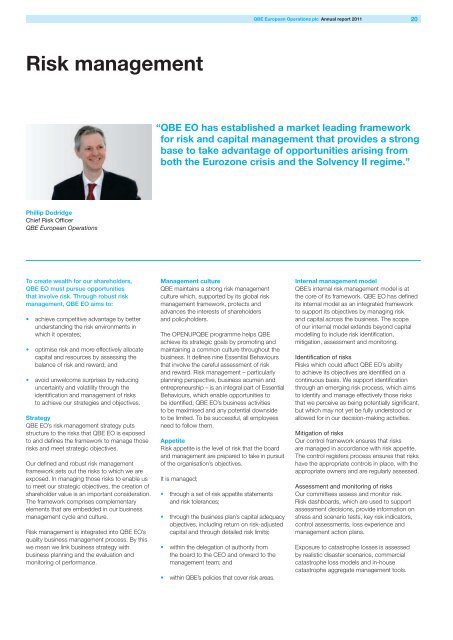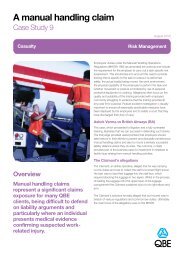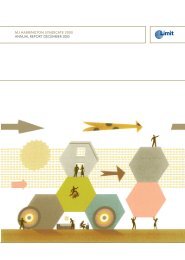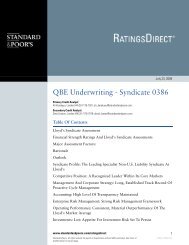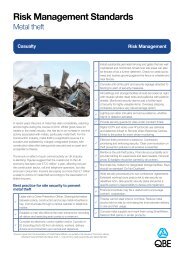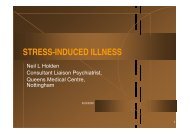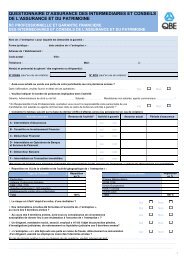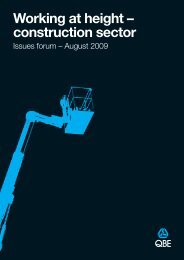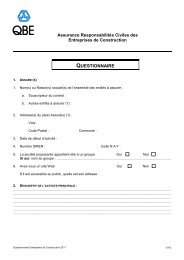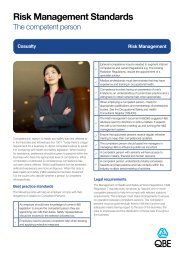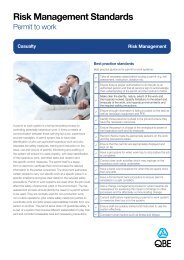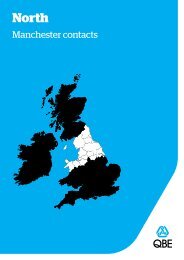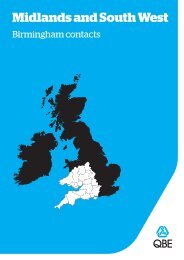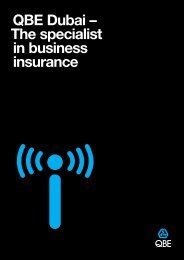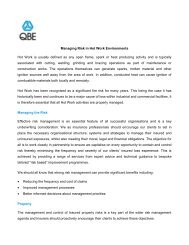QBE European Operations plc
QBE European Operations plc
QBE European Operations plc
Create successful ePaper yourself
Turn your PDF publications into a flip-book with our unique Google optimized e-Paper software.
<strong>QBE</strong> <strong>European</strong> <strong>Operations</strong> <strong>plc</strong> Annual report 2011 20<br />
Risk management<br />
“<strong>QBE</strong> EO has established a market leading framework<br />
for risk and capital management that provides a strong<br />
base to take advantage of opportunities arising from<br />
both the Eurozone crisis and the Solvency II regime.”<br />
Phillip Dodridge<br />
Chief Risk Officer<br />
<strong>QBE</strong> <strong>European</strong> <strong>Operations</strong><br />
To create wealth for our shareholders,<br />
<strong>QBE</strong> EO must pursue opportunities<br />
that involve risk. Through robust risk<br />
management, <strong>QBE</strong> EO aims to:<br />
• achieve competitive advantage by better<br />
understanding the risk environments in<br />
which it operates;<br />
• optimise risk and more effectively allocate<br />
capital and resources by assessing the<br />
balance of risk and reward; and<br />
• avoid unwelcome surprises by reducing<br />
uncertainty and volatility through the<br />
identification and management of risks<br />
to achieve our strategies and objectives.<br />
Strategy<br />
<strong>QBE</strong> EO’s risk management strategy puts<br />
structure to the risks that <strong>QBE</strong> EO is exposed<br />
to and defines the framework to manage those<br />
risks and meet strategic objectives.<br />
Our defined and robust risk management<br />
framework sets out the risks to which we are<br />
exposed. In managing those risks to enable us<br />
to meet our strategic objectives, the creation of<br />
shareholder value is an important consideration.<br />
The framework comprises complementary<br />
elements that are embedded in our business<br />
management cycle and culture.<br />
Risk management is integrated into <strong>QBE</strong> EO’s<br />
quality business management process. By this<br />
we mean we link business strategy with<br />
business planning and the evaluation and<br />
monitoring of performance.<br />
Management culture<br />
<strong>QBE</strong> maintains a strong risk management<br />
culture which, supported by its global risk<br />
management framework, protects and<br />
advances the interests of shareholders<br />
and policyholders.<br />
The OPENUP<strong>QBE</strong> programme helps <strong>QBE</strong><br />
achieve its strategic goals by promoting and<br />
maintaining a common culture throughout the<br />
business. It defines nine Essential Behaviours<br />
that involve the careful assessment of risk<br />
and reward. Risk management – particularly<br />
planning perspective, business acumen and<br />
entrepreneurship – is an integral part of Essential<br />
Behaviours, which enable opportunities to<br />
be identified, <strong>QBE</strong> EO’s business activities<br />
to be maximised and any potential downside<br />
to be limited. To be successful, all employees<br />
need to follow them.<br />
Appetite<br />
Risk appetite is the level of risk that the board<br />
and management are prepared to take in pursuit<br />
of the organisation’s objectives.<br />
It is managed;<br />
• through a set of risk appetite statements<br />
and risk tolerances;<br />
• through the business plan’s capital adequacy<br />
objectives, including return on risk-adjusted<br />
capital and through detailed risk limits;<br />
• within the delegation of authority from<br />
the board to the CEO and onward to the<br />
management team; and<br />
• within <strong>QBE</strong>’s policies that cover risk areas.<br />
Internal management model<br />
<strong>QBE</strong>’s internal risk management model is at<br />
the core of its framework. <strong>QBE</strong> EO has defined<br />
its internal model as an integrated framework<br />
to support its objectives by managing risk<br />
and capital across the business. The scope<br />
of our internal model extends beyond capital<br />
modelling to include risk identification,<br />
mitigation, assessment and monitoring.<br />
Identification of risks<br />
Risks which could affect <strong>QBE</strong> EO’s ability<br />
to achieve its objectives are identified on a<br />
continuous basis. We support identification<br />
through an emerging risk process, which aims<br />
to identify and manage effectively those risks<br />
that we perceive as being potentially significant,<br />
but which may not yet be fully understood or<br />
allowed for in our decision-making activities.<br />
Mitigation of risks<br />
Our control framework ensures that risks<br />
are managed in accordance with risk appetite.<br />
The control registers process ensures that risks<br />
have the appropriate controls in place, with the<br />
appropriate owners and are regularly assessed.<br />
Assessment and monitoring of risks<br />
Our committees assess and monitor risk.<br />
Risk dashboards, which are used to support<br />
assessment decisions, provide information on<br />
stress and scenario tests, key risk indicators,<br />
control assessments, loss experience and<br />
management action plans.<br />
Exposure to catastrophe losses is assessed<br />
by realistic disaster scenarios, commercial<br />
catastrophe loss models and in-house<br />
catastrophe aggregate management tools.


